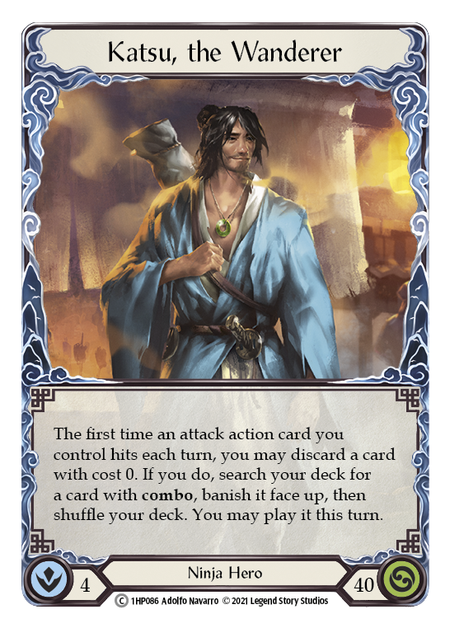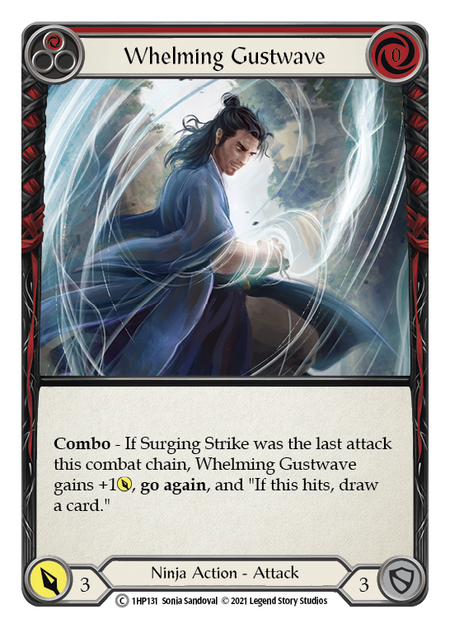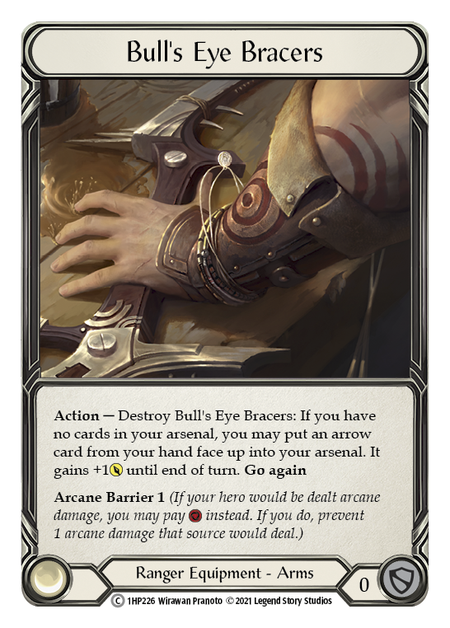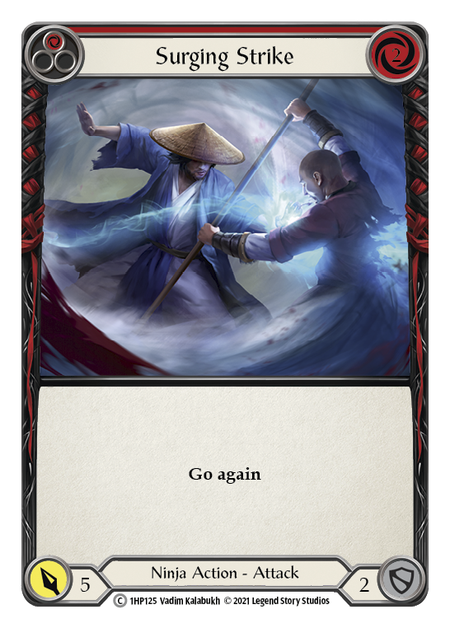In my previous article, I talked about assessing game state through a very limited framework. We wanted to figure out who was winning from a snapshot of the game using only life and cards in hand.
With Bull’s Eye Bracer banned, I figured the next logical step is to assess the value of equipment and why it is so frequently targeted in balance adjustments. Unfortunately, this is quite a bit muddier, but no less valuable.
Knowing how to assess the value of equipment can do wonders for deck construction. Finding value where other people may have overlooked it might give your deck that extra edge. Or you could use this knowledge to develop matchup theory and uncover new strategies. In any case, Flesh and Blood is a game where many interactions can be modeled in terms of value exchanges, even if they are not immediately obvious.
My goal here is to help demystify the power of equipment.
Defensive Value
When talking about assessment, I try to use the term "value" instead of "damage" wherever possible, because value is always trying to capture the sum of our damage dealt AND prevented. This is relevant when discussing armor, because it represents purely defensive value, which is no less important than offensive value.
At its very most basic, equipment can be assessed purely by its block value. This works somewhat, but it doesn’t capture the value of preventing on-hits. The best example to understand why this is important is the Katsu vs Bravo match up.


The conventional Bravo equipment suite of Crown of Providence, Tectonic Plating, Crater Fist, and Ironrot Legs represents 9 armor over 6 individual blocks. Katsu might submit Breeze Rider Boots, Breaking Scales, Heartened Cross Strap, and Mask of Momentum - 4 armor over 3 blocks.
This deficit might not seem incredibly significant, but it does not remotely capture the texture of a game. In terms of printed damage output, both heroes are fairly close: all of Bravo’s attacks are appropriately costed for their power, and Katsu is similar. Despite this, the trajectory of a game between these two heroes is a roller coaster. The real battle occurring doesn’t lie in the damage, but in the on-hit effects.
Bravo’s worst crush effects have game-losing consequences, and Katsu is poorly equipped to manage them on the best of days. Katsu presents a flurry of on-hit triggers, but his best turns rely on landed hits to trigger his ability to search up his power cards - all of which are relatively low damage and easily covered by Bravo’s armor, or at worst armor and a card. This usually results in Bravo generating a massive lead where most of his on-hits land and Katsu gets none.


However, the story changes if Katsu survives after expending Bravo’s armor. Each turn, he can threaten Mask of Momentum (a drawn card) or other powerful on-hits in ways that are very expensive to block without armor. If Katsu threatens a drawn card on a 4-power attack, Bravo will most likely have to block with 2 cards. His attacks become so expensive to block that he rapidly claws back into the game, and can overtake Bravo if unchecked.
So what happened here? In terms of a pure value proposition, we might assess any given drawn card as a potential 3 value. Either it improves the damage of a hand at this rate, or it allows us to block with an additional card next turn if we arsenal it. Sometimes it will be less, sometimes it will be a lot more, but 3 is a very reasonable expectation.
If Bravo has no armor and is facing down a card draw on-hit at a 4 power breakpoint, he is put in a bad spot. He can either take 4 damage and give up the card (4 damage + a drawn card = -7 value); block with 1 card, take 1 and give up the card (1 damage + a card spent + a card drawn = -7 value); or block with 2 cards (2 cards spent = -6 value). Whatever option he chooses, he is falling behind disproportionately to the power of the card attacking him. That being said, blocking with 2 cards costs him the least value and is thus the best option; and having armor here would have saved him a whole card of value. Therefore, in terms of defensive utility, Bravo’s 6 instances of armor blocks represents up to 6 extra cards he is bringing into the matchup - a huge advantage in a quick game, but one that can be overcome with time and patience.
If we’re to assess the value of armor, we can’t just say each blocking instance represents a full card - the previous example is the absolute ceiling of what armor represents. That being said, most decks have at least a couple on-hits of that power level, and maybe a few more that are weaker but still generate value. The tension of using armor in a match is getting as close as possible to a full card of value for each block, without waiting too long and being forced to use the armor expressly to preserve life.
In general, the less armor you have, the more likely you’ll find a high value block for it, with the risk of being forced to give up value to powerful on-hits earlier once that armor is expended. Some decks - like Rhinar - have virtually zero on-hit triggers, which means armor is only worth its printed defense value. The value of armor, therefore, is a variable of the matchup.
Offensive Value



What do Heartened Cross Strap, Stubby Hammerers, and Bull’s Eye Bracer have in common? They are all commons designed for draft; they all have offensive, one time use effects; aaaaand they’re all banned in at least one format. What is the deal with these cards?
If we look at them under the context that they were meant to be played, they all offer very similar effects: a reasonable amount of value generation that is basically guaranteed each game. This, in of itself, is nowhere near ban-worthy, so let’s investigate one of these cards more closely.
Why is Heartened Cross Strap banned in blitz?
The article justifying the ban did not provide much detail, saying that one-turn-kill (OTK) decks were becoming problematic in Blitz and this was an effort to curb that play pattern. It reduces the cost of an attack action by 2 resources. By our value paradigm, 2 resources lets us play a card that deals 2 more damage, making resources and damage very near equivalent - so why isn’t Goliath Gauntlet banned? For that we need to investigate the context of the ban.

At the time, Rhinar was a powerful, consistent OTK deck using Bloodrush Bellow and Mandible Claws to deal over 20 damage in a turn. While extremely powerful, Bloodrush Bellow has a drawback: 2 of the cards you need to fuel your offense that turn are being drawn blind. You’ll always have a chance to draw poorly and deal significantly less damage.
In these cases, Heartened Cross Strap supports Rhinar’s economy such that he can swing with a Mandible Claw he would otherwise be unable to afford. This effectively represents 5 damage instead of our previously assumed 2 damage, pushing it into the realm of Stubby Hammerers - which Fai was usually able to leverage for 6 damage.
Similarly, in Yuki’s article on the subject, she assessed Bull’s Eye Bracer at 7 damage - prophetic considering it was banned only months later. The common thread that connects the banning of these cards is that they unlock synergistic plays that represent too much value for one card that starts on the field.
Uncovering this “secret” value of Heartened Cross Strap drove me to design a new Classic Constructed Rhinar deck - one that didn’t only use the card to fix a volatile economy, but to support turns that were even bigger - without sacrificing consistency. This deck allowed me to qualify for Pro Tour: Baltimore.
So to review, armor can be valued somewhere between its printed defense value and a full card per block, depending on the matchup; and equipment effects should be assessed by the value unlocked by their common synergies. The implication of this is that most heroes start the game with an intimidating amount of value in play - meaning we should closely interrogate the equipment pieces we’re using when we start designing our own loadouts.
Weighing Options

To me, the most interesting instance of this right now is the inclusion of Heartened Cross Strap in Katsu. Its nominal function in the deck is to bankroll a Surging Strike, letting you start your offense with fewer cards. It also bails you out of certain precarious hands where you have a Surging Strike and 3 other red cards. In the first case, it represents a very fair 2 resources saved; but the other use case saves you pitching 2 reds. This second use is critical because it represents 2 extra cards we would otherwise have to pitch, making it the preferred choice of chest piece.
That being said, I prefer Fyendal’s Spring Tunic because it can generate significant value over a game. So let's compare them.
The probability of drawing the dreaded Surging Strike + 3 red hand each turn is around 6.7% in a standard Katsu list. It’s low, but not insignificant - as anyone who activates Scabskin Leathers will tell you, the more you do something risky, the more likely it is that something bad happens. By turn 3, you have approximately a 20% chance to draw this hand, 35% by turn 6, and 50% by turn 9. Of course these numbers aren’t precise, but they’re sufficient to illustrate my argument.
In any case, what we see is that, in a short game, the Cross Strap will likely be used for 2 resources; and as the game progresses, it gets more likely that it will be used instead to save us from The Dreaded Hand.
Tunic, on the other hand, represents a Kodachi swing every 3 turns or so. 1 damage isn’t particularly exciting in and of itself; but used creatively, it will generate Mask of Momentum threats in places you wouldn’t otherwise get them. If you structure these Mask threats on 4-power attacks, you create those situations where your opponent must spend their cards inefficiently or face worse consequences.
The sticky part of this argument is that it is much harder to quantify how often this event occurs. But naturally, the longer the game goes, the more likely it can extract multiple extra cards from the opponent. To directly compare it to Cross Strap, in cases where we draw The Dreaded Hand, Tunic isn’t worthless: where Cross Strap saves us 2 cards, Tunic saves 1, and can do so multiple times.
The icing on top is the 1 point of armor, which like other armor pieces, we’re looking for an opportunity to leverage for a full card (after we’ve gotten our resources).
In the end, there is no obvious choice between the two chest pieces. I find Tunic to be more versatile, conducive to skill expression, and rewards strong defensive play. Cross Strap has a concrete range of value of ‘usually acceptable’ to ‘sometimes excellent’.
The important part is that we are better informed by the strengths that each piece offers and can make decisions based on what we value more.




